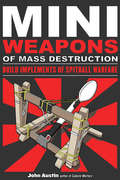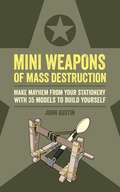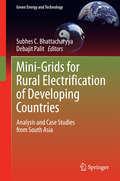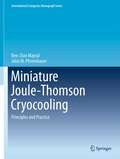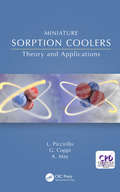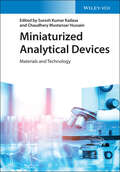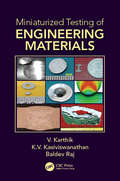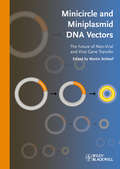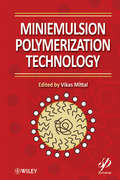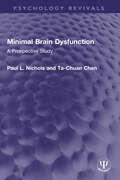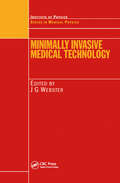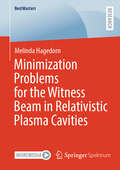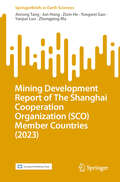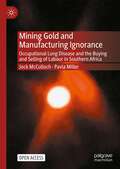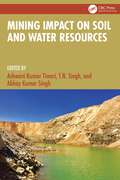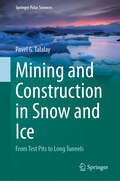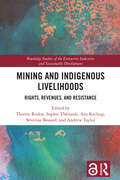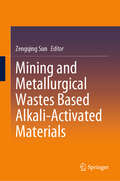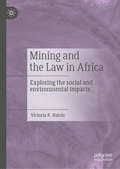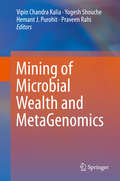- Table View
- List View
Mini Weapons of Mass Destruction: Build Implements Of Spitball Warfare (Mini Weapons of Mass Destruction)
by John AustinWith the advent of modern household products and office supplies--binder clips, clothespins, rubber bands, ballpoint pens, toothpicks, paper clips, plastic utensils, and matches and barbeque lighters--troublemakers of all stripes have the components needed to build an impressive, if somewhat miniaturized, arsenal. Detailed, step-by-step instructions for each project are provided, including materials and ammo lists, clear diagrams, and construction tips. The 35 devices include catapults, slingshots, minibombs, darts, and combustion shooters--build a tiny trebuchet from paper clips and a D-cell battery, wrap a penny in a string of paper caps to create a surprisingly impressive "bomb," and convert champagne party poppers and pen casings into a three-barreled bazooka. Finally, plans are provided for a top secret concealing book to hide your stash, as well as targets--cardboard critters, big-headed aliens, and zombies--for shooting practice. Never let your cubicle, home office, or personal space go undefended again!
Mini Weapons of Mass Destruction: Make mayhem from your stationery with 35 models to build yourself (Mini Weapons of Mass Destruction)
by John AustinWe've come a long way from the Peashooter Era: with the advent of modern household products and office supplies - foldback clips, clothespins, rubber bands, ballpoint pens, toothpicks, paper clips and plastic utensils - the everyday junk drawer can hold all the materials needed to create pocket-sized weaponry. Whether you're slowing dying of boredom in a stuffy office, plotting revenge on your older siblings or simply looking for a wonderful way to kill some time, this book is for you. Toy designer John Austin provides detailed, step-by-step instructions for each project, including materials and ammo lists, clear pictures, and construction tips, for mayhem-loving MacGyvers. The 35 devices include catapults, slingshots, darts, crossbows, and combustion shooters. Build a tiny trebuchet from paper clips and a D-cell battery. Wrap a penny in a string of paper caps to create a surprisingly impressive "bomb." Several of the projects even include variations where combatants mount laser pointer sights to their shooters to increase their accuracy. The instructions are simple so that anyone can make these wacky innovations in minutes whilst also learning about mechanics and physics in a fun, hands-on way.
Mini-Grids for Rural Electrification of Developing Countries
by Subhes C. Bhattacharyya Debajit PalitIn recognition of the fact that billions of people in the developing world do not have access to clean energies, the United Nations launched the Sustainable Energy for All Initiative to achieve universal energy access by 2030. Although electricity grid extension remains the most prevalent way of providing access, it is now recognized that the central grid is unlikely to reach many remote areas in the near future. At the same time, individual solutions like solar home systems tend to provide very limited services to consumers. Mini-grids offer an alternative by combining the benefits of a grid-based solution with the potential for harnessing renewable energies at the local level. The purpose of this book is to provide in-depth coverage of the use of mini-grids for rural electrification in developing countries, taking into account the technical, economic, environmental and governance dimensions and presenting case studies from South Asia. This book reports on research carried out by a consortium of British and Indian researchers on off-grid electrification in South Asia. It provides state-of-the art technical knowledge on mini-grids and micro-grids including renewable energy integration (or green mini-grids), smart systems for integration with the central grid, and standardization of systems. It also presents essential analytical frameworks and approaches that can be used to analyze the mini-grids comprehensively including their techno-economic aspects, financial viability and regulatory issues. The case studies drawn from South Asia demonstrate the application of the framework and showcase various successful efforts to promote mini-grids in the region. It also reports on the design and implementation of a demonstration project carried out by the team in a cluster of villages in Odisha (India). The book's multi-disciplinary approach facilitates understanding of the relevant practical dimensions of mini-grid systems, such as demand creation (through interventions in livelihood generation and value chain development), financing, regulation, and smart system design. Its state-of-the art knowledge, integrated methodological framework, simulation exercises and real-life case analysis will allow the reader to analyze and appreciate the mini-grid-related activities in their entirety. The book will be of interest to researchers, graduate students, practitioners and policy makers working in the area of rural electrification in developing countries.
Miniature Joule-Thomson Cryocooling
by John M. Pfotenhauer Ben-Zion MaytalThis book is the first in English being entirely dedicated to Miniature Joule-Thomson Cryocooling. The category of Joule-Thomson (JT) cryocoolers takes us back to the roots of cryogenics, in 1895, with figures like Linde and Hampson. The "cold finger" of these cryocoolers is compact, lacks moving parts, and sustains a large heat flux extraction at a steady temperature. Potentially, they cool down unbeatably fast. For example, cooling to below 100 K (minus 173 Celsius) might be accomplished within only a few seconds by liquefying argon. A level of about 120 K can be reached almost instantly with krypton. Indeed, the species of coolant plays a central role dictating the size, the intensity and the level of cryocooling. It is the JT effect that drives these cryocoolers and reflects the deviation of the "real" gas from the ideal gas properties. The nine chapters of the book are arranged in five parts. *The Common Principle of Cyrocoolers shared across the broad variety of cryocooler types *Theoretical Aspects: the JT effect and its inversion, cooling potential of coolants, the liquefaction process, sizing of heat exchangers, level of pressurization, discharge of pressure vessels * Practical Aspects: modes of operation (fast cooldown, continuous, multi-staging, hybrid cryocoolers), pressure sources, configuration, construction and technologies, flow adjustment, MEMS, open and closed cycle, cooldown process and similarity, transient behavior * Mixed Coolant cryocooling: theory, practice and applications * Special Topics: real gas choked flow rates, gas purity, clog formation, optimal fixed orifice, modeling, cryosurgical devices, warming by the inverse JT effect The theoretical aspects may be of interest not only to those working with cryocoolers but also for others with a general interest in "real" gas thermodynamics, such as, for example, the inversion of the JT effect in its differential and integral forms, and the exceptional behavior of the quantum gases. A detailed list of references for each chapter comprises a broad literature survey. It consists of more than 1,200 relevant publications and 450 related patents. The systematically organized content, arranged under a thorough hierarchy of headings, supported by 227 figures and 41 tables, and accompanied by various chronological notes of evolution, enables readers a friendly interaction with the book. Dr. Ben-Zion Maytal is a Senior Researcher at Rafael-Advanced Defense Systems, Ltd., and an Adjunct Senior Teaching Fellow at the Technion-Israel Institute of Technology, Haifa, Israel. Prof. John M. Pfotenhauer holds a joint appointment in the Departments of Mechanical Engineering and Engineering Physics at the University of Wisconsin - Madison.
Miniature Sorption Coolers: Theory and Applications
by Andrew May Lucio Piccirillo Gabriele CoppiIn recent years, there have been significant developments in detector technologies in the field of astrophysics, requiring lower temperatures with simple self-contained refrigerators. Temperatures in the range of 1K to 50mK are now achieved by using dedicated closed-cycle miniature sorption coolers. <P><P>This book presents the theoretical and experimental knowledge necessary to design and build your own miniature refrigerators, including both single shot and continuous 1 K, 300 mK and 100 mK coolers, and details how to write the needed design software. This text will be of interest to students and researchers, already familiar with basic physics and thermodynamics, who want to understand how sorption coolers and miniature dilution refrigerators work. <P><P>Features: <li>The first book dedicated to miniature sorption coolers <li>Covers the basic thermodynamic concepts needed to understand the behavior of liquid helium-3 and liquid helium-4 <li>Includes an appendix of Python example codes
Miniaturized Analytical Devices: Materials and Technology
by Chaudhery Mustansar Hussain Suresh Kumar KailasaMiniaturized Analytical Devices An in-depth overview of integrating functionalized nanomaterials with mass spectrometry, spectroscopy, electrophoresis, and other important analytical techniques Miniaturized Analytical Devices: Materials and Technology is an up-to-date resource exploring the analytical applications of miniaturized technology in areas such as clinical microbiology, pharmaceuticals, agriculture, and environmental analysis. The book covers the integration of functional nanomaterials in mass spectrometry, microscopy, electrophoresis, and more—providing the state-of-the-art information required for successfully implementing a range of chemical analysis techniques on microchips. Featuring contributions from a panel of international experts in the field, the book begins with an introduction to selected miniaturized devices, nanomaterials, and analytical methods. Subsequent sections describe functionalized nanomaterials (FNMs) for miniaturized devices and discuss techniques such as miniaturized mass spectrometry for bioassays and miniaturized microscopy for cell imaging. The book concludes by exploring a variety of applications of miniaturized devices in areas including metal analysis, bioimaging, DNA separation and analysis, molecular biology, and more. This timely volume: Surveys the current state of the field and provides a starting point for developing faster, more reliable, and more selective analytical devices Focuses on the practical applications of miniaturized analytical devices in materials science, clinical microbiology, the pharmaceutical industry, and environmental analysis Covers a wide range of materials and analytical techniques such as microvolume UV-VIS spectroscopy, microchip and capillary electrophoresis, and matrix assisted laser desorption ionization-mass spectrometry (MALDI-MS) analysis Discusses the role of miniaturized analytical devices in securing a green and sustainable future Miniaturized Analytical Devices: Materials and Technology is essential reading for analytical chemists, analytical laboratories, materials scientists, biologists, life scientists, and advanced students in related fields.
Miniaturized Biosensing Devices: Fabrication and Applications
by Pranjal Chandra Kuldeep MahatoThis book presents tools and techniques for the development of miniature biosensors and their applications. The initial chapters discuss the advancements in the development of the transduction techniques, including optical, electrochemical, and piezoelectric, which are used for miniaturized biosensors. The book also reviews several technologies, such as nanotechnology, nanobiotechnology, immune-technology, DNA-technology, micro-manufacturing technology, electronic-circuit technology to increase the miniaturization and sensitivity of the biosensor platform. Subsequently, the chapters illustrate the applications of miniaturized biosensing systems in point-of-care monitoring of treatment and disease progression, environmental monitoring, food control, drug discovery, forensics, and biomedical research. Towards the end, the book discusses the advanced applications of biosensors in water quality monitoring, especially on-line detection systems and on-site detection of pesticides, heavy metals and bacteria in water. This book is an invaluable source for scientists working in biochemical engineering, bioengineering, and biomedical engineering in academia and industry.
Miniaturized Testing of Engineering Materials (Advanced Materials Science and Technology)
by Baldev Raj V. Karthik K.V. KasiviswanathanThis book is a comprehensive overview of methods of characterizing the mechanical properties of engineering materials using specimen sizes in the micro-scale regime (0.3-5.0 mm). A range of issues associated with miniature specimen testing like correlation methodologies for data transferability between different specimen sizes, use of numerical simulation/analysis for data inversion, application to actual structures using scooped out samples or by in-situ testing, and more importantly developing a common code of practice are discussed and presented in a concise manner.
Minicircle and Miniplasmid DNA Vectors: The Future of Non-viral and Viral Gene Transfer
by Martin SchleefThis first title on the topic provides complete coverage, including the molecular basis, production and possible biomedical applications. Written by the most prominent academic researchers in the field as well as by researchers at one of the world's leading companies in industrial production of minicircle DNA, this practical book is aimed at everyone who is directly or indirectly involved in the development of gene therapies.
Miniemulsion Polymerization Technology (Wiley-Scrivener #34)
by Vikas MittalExplains miniemulsion technology and techniques and why they have many distinct advantages over the conventional emulsion polymerization technology Miniemulsion Polymerization Technology comprises 10 papers by many of the world's experts on the subject. It summarizes the recent advances in miniemulsion polymerization technology including the advances on the selection of surfactants and co-surfactants, the expansion of miniemulsion technology in various polymers and co-polymer systems, and the use of miniemulsion polymerization for the synthesis of advanced polymer particle morphologies. There have been a large number of texts on emulsion and other forms of polymerization methods, but miniemulsion polymerization, though it provides unique routes for polymer particle synthesis, has been neglected. This edited volume: Details the use of miniemulsion polymerization in encapsulation, core shell functional particles, nitroxide mediated polymerization, atom transfer radical polymerization or radical addition fragmentation chain transfer polymerization, to generate advanced polymer nanoparticles or organic-inorganic composite particles Examines the wide spectrum of commercial possibilities of miniemulsion polymerization Provides both introductory material as well as deep insights into the synthesis of polymer particles
Minimal Brain Dysfunction: A Prospective Study (Psychology Revivals)
by Paul L. Nichols Ta-Chuan ChenThe concept of Minimal Brain Dysfunction (a previous term for ADHD) has had a tumultuous, and some would say, checkered history. Originally published in 1981, this title was one of a series of volumes dealing with specific developmental problems in children whose mothers registered for prenatal care in the Collaborative Perinatal Project (NCPP) of the National Institute of Neurological and Communicative Disorders and Stroke (NINCDS). In this volume, relationships between symptoms of minimal brain dysfunction and more than 300 prenatal and postnatal variables are examined in a cohort of nearly 30,000 7-year-old children. Despite greater understanding more recently, diagnosis and treatment continue to cause controversy. This is an early investigation into the concept of MBD and its causes, today it can be read in its historical context.
Minimal Cells: Design, Construction, Biotechnological Applications
by Guillermo Gosset Alvaro R. LaraThis book provides a comprehensive overview of the design, generation and characterization of minimal cell systems. Written by leading experts, it presents an in-depth analysis of the current issues and challenges in the field, including recent advances in the generation and characterization of reduced-genome strains generated from model organisms with relevance in biotechnology, and basic research such as Escherichia coli, Corynebacterium glutamicum and yeast. It also discusses methodologies, such as bottom-up and top-down genome minimization strategies, as well as novel analytical and experimental approaches to characterize and generate minimal cells. Lastly, it presents the latest research related to minimal cells of serveral microorganisms, e.g. Bacillus subtilis.The design of biological systems for biotechnological purposes employs strategies aimed at optimizing specific tasks. This approach is based on enhancing certain biological functions while reducing other capacities that are not required or that could be detrimental to the desired objective. A highly optimized cell factory would be expected to have only the capacity for reproduction and for performing the expected task. Such a hypothetical organism would be considered a minimal cell. At present, numerous research groups in academia and industry are exploring the theoretical and practical implications of constructing and using minimal cells and are providing valuable fundamental insights into the characteristics of minimal genomes, leading to an understanding of the essential gene set. In addition, research in this field is providing valuable information on the physiology of minimal cells and their utilization as a biological chassis to which useful biotechnological functions can be added.
Minimally Invasive Medical Technology
by John G. WebsterMinimally invasive medicine has the goal of providing health care with minimal trauma. When minimally invasive surgery is utilized, it reduces the length of hospital stays, lowers costs, lowers pain, and reduces blood loss. Other minimally invasive techniques minimize radiation exposure, tissue damage, and drug side effects. Collecting cont
Minimization Problems for the Witness Beam in Relativistic Plasma Cavities (BestMasters)
by Melinda HagedornThis thesis deals with an optimization problem from the field of theoretical plasma physics. Specifically, it deals with the question of how the accelerated electrons are spatially arranged in a plasma wave generated by a laser pulse. An internal structure of this so-called witness beam is of interest for the radiation characteristics of such electron beams, in particular with regard to the coherence of the generated radiation. The resulting internal structure of the electron beam is a result of the interaction of the electrons with each other and the electric fields of the wakefield, therefore it is determined by solving a minimization problem. The thesis builds on previous results in this field and aims to find suggestions for improved algorithms to determine the minimum sought.
Minimum Quantity Lubrication Machining: Process Analysis and Analytical Modeling
by Xia JiThis book focuses on the effect of minimum quantity lubrication (MQL) on the mechanical and thermal history, which will mainly determine the quality of the machined components. By analyzing the details of the lubrication and cooling effects in MQL machining, the book provides readers with an accurate and fast way to predict the residual stress of machined components. These process analyses and quality prediction will be beneficial for understanding the MQL machining theory and its widespread application in industry.
Mining Development Report of The Shanghai Cooperation Organization (SpringerBriefs in Earth Sciences)
by Jun Hong Jinrong Tang Zixin He Yongwei Gao Yanjun Luo Zhongping MaThis is the first research report on mining development in the SCO member countries conducted by a Chinese research institute. It focuses on the economic development, mineral resources endowment and current status of mining development, mining investment environment, and cooperation in geosciences and mining industry between China and other SCO member countries. The aim of this book is to promote the practical cooperation in geoscience and mining in the SCO and to build a closer community of destiny for the development of mining industry in the SCO. The translation was done with the help of artificial intelligence. The present version has been revised technically and linguistically by the authors in collaboration with a professional translator.
Mining Gold and Manufacturing Ignorance: Occupational Lung Disease and the Buying and Selling of Labour in Southern Africa
by Pavla Miller Jock McCullochThis open access book charts how South Africa’s gold mines have systematically suppressed evidence of hazardous work practices and the risks associated with mining.For most of the twentieth century, South Africa was the world’s largest producer of gold. Although the country enjoyed a reputation for leading the world in occupational health legislation, the mining companies developed a system of medical surveillance and workers’ compensation which compromised the health of black gold miners, facilitated the spread of tuberculosis, and ravaged the communities and economies of labour-sending states. The culmination of two decades of meticulous archival research, this book exposes the making, contesting, and unravelling of the companies’ capacity to shape – and corrupt – medical knowledge.
Mining Impact on Soil and Water Resources
by T. N. Singh Ashwani Kumar Tiwari Abhay Kumar SinghThe subject matter of this book is divided into two sections detailing Soil (focussing on geochemistry, contamination, and remediation) and Water (focussing on hydrogeochemistry, crisis, desertification, and modelling) including case studies, review studies, and essential soil remediation and water. It also explores management practices to explain soil–water interaction, acid mine drainage problems, and contamination levels in water and soil resources. The main topics discussed include soil–water interaction, mining impact on water and soil geochemistry, mining impact on water and soil quality, martials impact, groundwater level depletion, contamination evaluation, health risk assessment, water treatment, soil remediation, remote sensing and geographical information system (GIS), contaminant transport modelling, and water/soil resources management. Emphasis is also given to the new approach to sustainable water and soil resources management.Features: Integrates research in soil and environmental resources management in mining. Describes soil resources management in mining regions. Covers water geochemistry and contaminant transport modelling. Provides solutions for acid mine drainage problems. Includes the role of remote sensing and GIS. This book is aimed at researchers and graduate students in soil resources management, mining, and environment science.
Mining Impacts and their Environmental Problems
by R. Nagarajan Al. Ramanathan Pankaj Kumar José Marrugo Negrete M. P. Jonathan S. ChidambaramThis book entitled “Mining Impacts and their Environmental Problems” presents a comprehensive view on various mining activities and a wide spectrum of environmental challenges associated with it. Case studies presented across global south such as Asia, Africa, and Latin America, are the first of its kind which presents a holistic and deep insight (into instead of about?) about this pressing environmental issue. In this book, thirteen chapters present various issues ranging from gold, silver, chromium, lead, coal mining, and its impacts on ambient environmental (soil, water, biodiversity) degradation and ultimately on(healthy living environment instead of human health living? ) human health living in the surrounding area. For this purpose, (different methodologies have been used) they have used different methodologies( for example instead of like using) like using (a) water quality index, hydro-chemical characterization, numerical simulation to identify the extent of pollution caused(by instead of due to?) due to mining activities. Later it (the book) advocates the usage of advance mining technologies such as advanced oxidation processes, decarbonization technologies and a biotechnological approach for the treatment of wastewater being generated due to mining activities or minimizing overall environmental degradation. Finally, it emphasizes on assessing risk zone delineation, vulnerability analysis using cutting edge tools like numerical simulation, GIS and remote sensing, which will help designing robust management plans and sustainable transitions, critically helpful for policy makers or decision makers.
Mining and Construction in Snow and Ice: From Test Pits to Long Tunnels (Springer Polar Sciences)
by Pavel G. TalalaySnow, firn, and ice are the most widespread cryogenic minerals on Earth’s surface. Their properties differ significantly from those of common minerals, and their excavation requires special approaches. The problems of mining and construction in snow and ice could be explained mostly by harsh climate conditions, logistics difficulties, environmental issues and snow-ice related challenges. The primary objective of this book is to list all feasible technologies for mining and construction in snow and ice, and to analyze these from the perspective of applications, problems, and hindrances. Although mining and construction in snow and ice appears exotic, it is significantly common for the production of snow and ice as a source of freshwater and construction material; accessing subglacial ore; the investigation and sampling of near-surface layers; glacier geoengineering works; recovering of snow-buried objects; construction of subsurface shelters for living, working, and military facilities; observation and investigation of glacier beds; construction of sightseeing ice tunnels; and drainage of ice-dammed proglacial lakes.
Mining and Indigenous Livelihoods: Rights, Revenues, and Resistance (Routledge Studies of the Extractive Industries and Sustainable Development)
by Andrew Taylor Sophie Thériault Thierry Rodon Arn Keeling Séverine BouardThis book maps the encounters between Indigenous Peoples and local communities with mining companies in various postcolonial contexts.Combining comparative and multidisciplinary analysis, the contributors to this volume shine a light on how the mining industry might adapt its practices to the political and legal contexts where they operate. Understanding these processes and how communities respond to these encounters is critical to documenting where and how encounters with mining may benefit or negatively impact Indigenous Peoples. The experiences and reflections shared by Indigenous and non-Indigenous contributors will enhance our understanding of evolving practices and of the different strategies and discourses developed by Indigenous Peoples to deal with mining projects. By mobilizing in-depth fieldwork in five regions—Australia, Canada, Sweden, New Caledonia, and Brazil—this body of work highlights voices often marginalized in mining development studies, including those of Indigenous Peoples and women.This book will be of great interest to students and scholars of mining and the extractive industries, sustainable development, natural resource management, and Indigenous Peoples.The Open Access version of this book, available at http://www.taylorfrancis.com, has been made available under a Creative Commons Attribution-Non Commercial-No Derivatives (CC-BY-NC-ND) 4.0 license.
Mining and Metallurgical Wastes Based Alkali-Activated Materials
by Zengqing SunThis book reviews the recent scientific developments on mining and metallurgical wastes-based alkali-activated materials (MMWAAMs). Enormous quantities of solid wastes are generated during the exploitation of ore deposits and the subsequent processing for materials, causing serious environmental problems. Alkali activation is one of the robust technologies that converts mining and metallurgical wastes into value-added materials and offers technological solutions for efficient stabilization of toxic components in mining and metallurgical wastes. Herein, this book presents the development of the design, processing routes, and performances of mining and metallurgical waste-based alkali-activated materials. It highlights in detail the relationships between the physicochemical characteristics of the source materials and the properties of synthesized binders. From the durability perspective, both the applicability of testing protocols and degradation mechanisms are also reviewed with significant experimental and modeling work presented. Furthermore, the transformation paths of initially toxic components during alkali activation, partitioning characteristics, as well as the assemblages of solubility-controlling mineral phases are discussed for detailed environmental compatibility evaluation. In addition, applications and perspectives for future directions of mining and metallurgical wastes-based alkali-activated materials are illustrated. By bringing state-of-the-art knowledge, this book appeals to a broad readership, particularly researchers engaged in material and environmental science, mining and metallurgical engineering, and other related fields.
Mining and Selling Radium and Uranium
by Roger F. RobisonPresented here is the story of the mining and sale of uranium and radium ore through biographical vignettes, chemistry, physics, geology, geography, occupational health, medical utilization, environmental safety and industrial history. Included are the people and places involved over the course of over 90 years of interconnected mining and sale of radium and uranium, finally ending in 1991 with the abandonment of radium paint and medical devices, Soviet nuclear parity, and the Radiation Exposure Compensation Act.
Mining and the Law in Africa: Exploring the social and environmental impacts
by Victoria R. NaluleThe mining sector has been an integral part of economic development in many African countries. Although minerals have been exploited for decades in these countries, the benefits have not always been as visible. This has necessitated reforms including nationalisation of mining activities in the distant past; and currently legal and regulatory reforms. This book gives an insight of these reforms and with reference to the fieldwork research undertaken by the author in some African countries, the book highlights the social and environmental impacts of mining activities in Africa. The central question of the book is, why the mining laws have worked in some countries but not others and what can be done to ensure that these laws are effective? Consequently, the book analyses the legal reforms made in the sector and highlights both the challenges and the opportunities for foreign investors as well as the African governments and local communities. The book will be of great interest to researchers and students in Energy and Geography related fields, as well as to practitioners and policy makers.
Mining of Microbial Wealth and MetaGenomics
by Vipin Chandra Kalia Yogesh Shouche Hemant J. Purohit Praveen RahiThe existence of living organisms in diverse ecosystems has been the focus of interest to human beings, primarily to obtain insights into the diversity and dynamics of the communities. This book discusses how the advent of novel molecular biology techniques, the latest being the next-generation sequencing technologies, helps to elucidate the identity of novel organisms, including those that are rare. The book highlights the fact that oceans, marine environments, rivers, mountains and the gut are ecosystems with great potential for obtaining bioactive molecules, which can be used in areas such as agriculture, food, medicine, water supplies and bioremediation. It then describes the latest research in metagenomics, a field that allows elucidation of the maximum biodiversity within an ecosystem, without the need to actually grow and culture the organisms. Further, it describes how human-associated microbes are directly responsible for our health and overall wellbeing.
